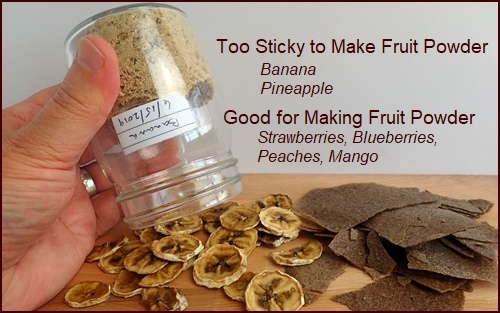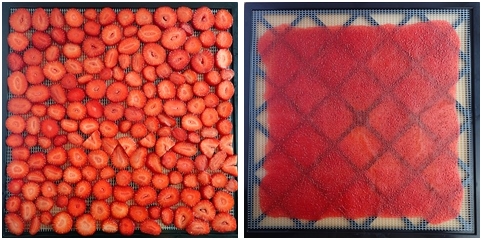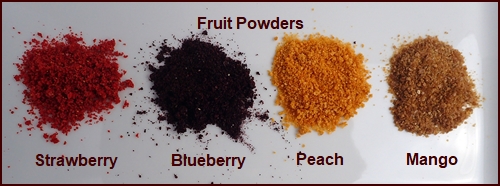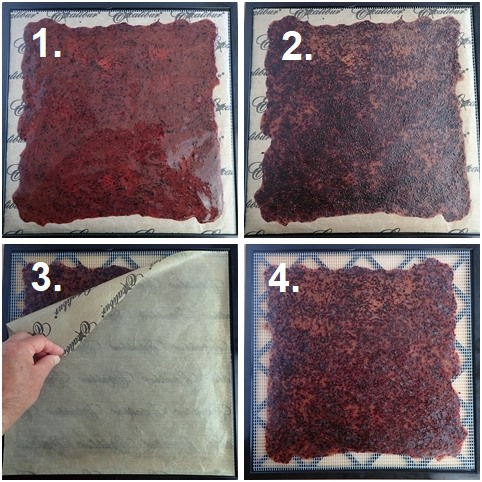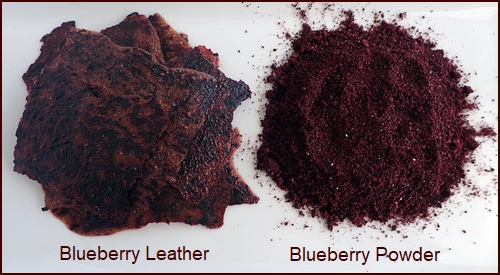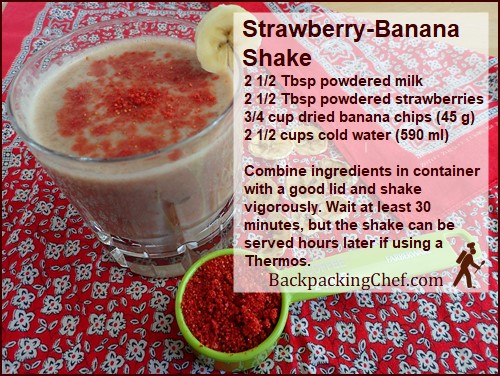| Back to Back Issues Page |
 |
|
June 2019 Trail Bytes: How to Make Fruit Powders and Milkshakes for the Trail. June 28, 2019 |
| Hello, In this edition of Trail Bytes, we explore the sticky business of making fruit powder. Can dried fruit pieces or fruit leather be ground into powder in a blender? If yes, then dried fruit powders offer another way to fortify backpacking menus with more nutrition, fiber, and quick energy. On the other hand, is the gain worth the time invested? Let’s find out. As expected, the higher the natural sugar content of each fruit tested, the more difficult it was to reduce the fruit to powder.
Photo above: Banana powder, chips, and leather. Bananas, Apples, and Pineapples – Not Good for Making Fruit Powder.The first fruits to rule out because of stickiness were bananas, apples, and pineapples. I managed to reduce dried banana slices to a lumpy powder in a blender, but the powder soon stuck together like cement, as shown in the upside down jar in the photo above. Ground dried pineapple pieces and dried apple pieces were a little less sticky as powders, but were still clumpy.Bananas, apples, and pineapples, while too sticky for making fruit powders, are ideal for making homemade granola bars. Their ability to bind ingredients keeps them in play for a future newsletter. One characteristic of dried banana slices or banana leather, is that they breakdown substantially when rehydrated with cold or hot water. With vigorous stirring or shaking, you can make banana pudding or banana milkshakes. Strawberries, Blueberries, Peaches, and Mangoes – Good for Making Fruit Powder.
I made strawberry powder two ways, once by drying and grinding strawberry slices, and once by making strawberry leather and grinding the leather into powder. Both methods worked, but the dried strawberry leather made a slightly better powder. The consistency was similar to brown sugar. Making leather was faster than drying sliced strawberries – there was less knife-work on the front end, and the leather dried faster than the thicker pieces.
I also made blueberry, peach, and mango powders from leather, as this seemed to be the more efficient method. How to Make Fruit LeatherInspect fruit, especially berries, for hidden mold.Wash fruit and trim away stems, leaves, pits, etc. Place fruit chunks or whole berries in blender, and blend until smooth. Spread one cup (236 ml) of blended fruit per Excalibur Dehydrator tray as shown in Photo 1 below. One cup of blended fruit will weigh approximately 225 grams, although there will be some variance between fruits.
Photos above: Stages of drying blueberry leather. Set dehydrator temperature to 135° F (57° C) and dry leather for eight to twelve hours. Times vary depending on many variables, such as the total amount of fruit in the dehydrator, juiciness of fruit, external humidity, etc. After six or seven hours, the leather should be sufficiently dry to flip. Photo 2 shows dried blueberry leather that is ready to flip. There is no moisture on the bottom side, and the leather adheres to the non-stick sheet. Flip the leather over onto the mesh sheet and peel away the non-stick sheet as shown in Photo 3. Continue drying for another hour or two as shown in Photo 4.
Photo above: Blueberry leather and powder. Finished fruit leather absorbs moisture from the air rapidly, so process and store it immediately in air-tight containers. Tear leather into smaller strips, and grind it into powder using a blender. Using Fruit PowdersHomemade fruit powders don’t dissolve instantly in water like Gatorade/Kool-Aid type powders. If you mix two tablespoons of fruit powder with one cup of cold water, the water will turn the color of the fruit. Within a few minutes, some pulp will float to the top or sink to the bottom. After a quick stir, the taste is mildly sweet and fruity with none of the excess sugar and artificial ingredients that you get with commercial drink powders.If you’re making Thermos fruit cocktails (one cup of dried fruit pieces plus two cups water), a tablespoon of berry powder tossed into the mix will add extra flavor and nutrition. Another use, that will earn you points for style, is to sprinkle fruit powder over your oatmeal. With my new supply of fruit powders, I opted to mix them into thick milkshakes. Strawberry-Banana Milkshake
Dried banana slices get soft and partially break down when rehydrated and shaken vigorously. Banana leather disintegrates completely. Either way, dried banana makes a thick, sweet milkshake. The longer you let bananas soak – preferably in an insulated Thermos Food Jar – the thicker your milkshake will turn out. Make a shake overnight to enjoy it for breakfast, or load up the thermos after breakfast or lunch to enjoy a cold shake a few hours later on the trail. Servings: 1 large Ingredients:
2½ cups cold water needed to rehydrate. (590 ml) * Milk powder is highly recommended, but may be omitted. ** Variations: Try blueberry and peach powders, too. At Home: Pack dried bananas/banana leather and strawberry powder in a small plastic bag. Pack milk powder separately. Dominique and I use powdered milk in our coffee, so we carry all powdered milk needed for a trip in one bag. If you plan to serve the shake in separate cups for two people, you might want to pack the strawberry powder separately. That way you can sprinkle a little colorful berry powder on top. On the Trail: Combine all ingredients with 2½ cups of cold, filtered water in a container with a secure lid. If serving within thirty minutes, shake vigorously several times. The quantities listed in this recipe are perfect to fill a 24-ounce Thermos Food Jar, while allowing space for the shaking action. If you use banana slices, some pieces will remain in the shake, but they will be very soft and tasty. Banana leather will completely dissolve, so your shake will be even thicker. Due to the effect of banana oxidation, combined with the dark pigments of berry powder, expect the color of the shake to be light-brown. Is Dehydrating Fruit Powder Worth the Effort?Maybe not. It takes a few seconds to grind fruit leather into powder, but then you have a blender to clean. Storing fruit powders means you’ll need to use more plastic bags or jars, which take up space. On the positive side, the concentrated flavors and bright colors of berry powders make them great toppings for oatmeal, milkshakes, and desserts.Berry-Banana Leather: Great Milkshakes in Less TimeA simpler solution: Instead of making berry powders separately, blend whole berries and bananas into one leather. Try a ratio of one-third berries and two-thirds bananas. Spread one cup of the blended mixture on each Excalibur Dehydrator tray.One Large Milkshake:
Rehydrate with 2½ cups cold, filtered water. Shake vigorously several times. Wait at least thirty minutes for best results, or prepare several hours in advance using a Thermos Food Jar. This berry-banana milkshake recipe is Dominique Approved. Sehr gut! With summer heat upon us, staying well-hydrated and well-nourished on the trail is essential. Imagine how delicious a berry-banana milkshake will taste – it would be almost as good as finding an ice cream stand in the woods. The temperature hit 99° F (37° C) here in Switzerland this week. It was a good week to make milkshakes. Stay cool. See you next month. Freundliche Grüsse,
Chef Glenn & Dominique P.S. If you have any questions or comments about this issue of Trail Bytes, please reply to this email or use this contact form. 

If you received this newsletter from a friend and would like to subscribe (it's free), subscribe here. Visit my BackpackingChef Facebook page for the lastest posts. Be sure to "follow" the page to continue seeing posts.
|
| Back to Back Issues Page |
